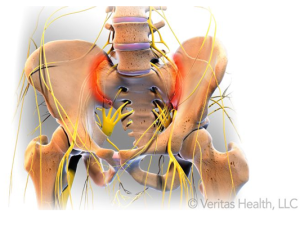By: Dr. Rami Rustum – January, 2016
 The sacroiliac (SI) joint is a strong weight bearing joint in the pelvis that connects the sacrum and pelvis. There are two joints, one on each side of the sacrum. This joint is reinforced by strong surrounding ligaments. Both joints move together as single unit to transmit upper body forces and provide shock absorption for the spine. A series of ridges and valleys in the joint fit together like a lock and key, much like if you put your knuckles together. There is a small amount of movement in this joint to allow for a walking gait pattern in normal human locomotion. Just like other joints in the body, this joint can become inflamed, unstable and dysfunctional.
The sacroiliac (SI) joint is a strong weight bearing joint in the pelvis that connects the sacrum and pelvis. There are two joints, one on each side of the sacrum. This joint is reinforced by strong surrounding ligaments. Both joints move together as single unit to transmit upper body forces and provide shock absorption for the spine. A series of ridges and valleys in the joint fit together like a lock and key, much like if you put your knuckles together. There is a small amount of movement in this joint to allow for a walking gait pattern in normal human locomotion. Just like other joints in the body, this joint can become inflamed, unstable and dysfunctional.
Causes of sacroiliac joint dysfunction:
As with most other joints in the body, the SI joints have a cartilage layer covering the bone. The cartilage allows for some movement and acts as a shock absorber between the bones. When this cartilage is damaged or worn away, the bones begin to rub on each other, and degenerative arthritis (osteoarthritis) occurs. This is the most common cause of SI joint dysfunction. Degenerative arthritis occurs commonly in the SI joints, just like other weight-bearing joints of the body.
Another common cause of SI joint dysfunction is pregnancy. During pregnancy, hormones are released in the woman’s body that allow ligaments to relax. This prepares the body for childbirth. Relaxation of the ligaments holding the SI joints together allows for increased motion in the joints and can lead to increased stresses and abnormal wear. The additional weight and walking pattern (altered gait) associated with pregnancy also places additional stress on the SI joints.
Any condition that alters the normal walking pattern places increased stress on the SI joints and is a risk factor for SI joint dysfunction. This could include a leg length discrepancy (one leg longer than the other), or pain in the hip, knee, ankle, or foot. Patients with severe pain in the lower extremity often develop problems with either the lower back (lumbar spine) or SI joints. Usually, if the underlying problem is treated, associated lumbar spine or SI joint dysfunction will also improve.
There are many disorders that affect the joints of the body that can also cause inflammation in the SI joints. These include gout, rheumatoid arthritis, psoriatic arthritis, reactive arthritis, and ankylosing spondylitis. These are all various forms of arthritis that can affect all joints. Ankylosing spondylitis is an inflammatory arthritis that always affects the SI joints. It can lead to stiffness and severe pain in the SI joints, due to inflammation in the sacroiliac joints (sacroiliitis). As the disease process continues, the SI joints can fuse together and have no range of motion. Once this occurs, there is no further pain associated with the SI joints. Rarely, bacterial infection can involve the sacroiliac joints.
Symptoms
Pain can be from inflammation of the sacroiliac joint, called sacroiliitis. This is commonly felt as pain on one side of the lower back to the right or left of midline where the joint is located. The inflamed joint can become dislocated, as if the lock and key grooves are in the wrong position. When SI joint dysfunction is severe, pain can refer to the hip, groin, buttocks, and even down the back of the thigh. Pain may be worse with movements that stress that joint, such as standing up from a seated position, walking up an incline, elliptical exercise, prolonged sitting or walking, or twisting when rolling in bed at night.
SI joint dysfunction or inflammation can mimic pain similar to degenerative hip disease, hip bursitis, lumbar disc herniation, or pinched nerves.
Treatment:
Initial conservative treatment options for the SI joint typically involve physical therapy, medications and injection management. Physical therapy works on manually readjusting the SI joint when it is immobilized or dislocated and provides stabilization exercises to long term management. Medications such as NSAIDs may be used to decrease overall inflammation. Localized steroid injections into the SI joint can provide targeted therapy to reduce pain and inflammation and allow physical therapy to make further progress. If the SI joint favorably responds to steroid injections but the benefits only last temporarily, another non-operative treatment is available called radiofrequency ablation, RFA.
When non-surgical treatments for the SI joint fail, surgical options provide permanent stability and pain reduction.
Dr. Rami Rustum of Merrimack Pain Management Associates is located at 280 Merrimack St, Lawrence, MA 01843 | Phone: (978) 685-2455
